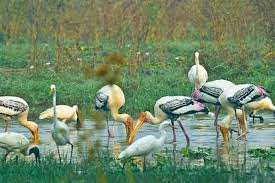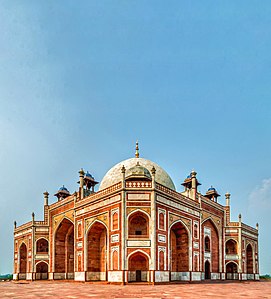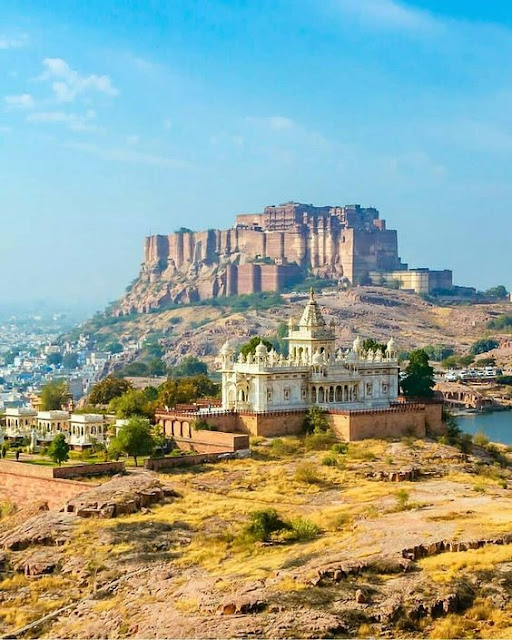Keoladeo National Park (Bharatpur) - 2019
Keoladeo National Park
Keoladeo National Park is a vast bird sanctuary and former royal game reserve in the north Indian state of Rajasthan. South of the ancient city of Bharatpur, the park’s woods and man-made wetlands protect over 350 species of migratory and resident birds, including herons, cormorants, and eagles. To the southeast, Fatehpur Sikri is home to sandstone temples and a mosque, built by Emperor Akbar in the 16th century.
Address: Agra-Jaipur Highway, Bharatpur, Rajasthan 302001
Area: 11.09 mi²
Hours:
Open now
Add full hours
Established: 10 March 1982
Phone: 05644 222 777
Number of visitors: 1,00,000
Nearest town: Bharatpur
UNESCO Site Id: 340
The rickshaw-puller cum guide made this experience awesome. He had good knowledge of the area as well as species and kept us well engaged. I would recommend taking a guide along, as you would need someone to show you around and tell you about the species. The cycle they offer for self-exploration is not up to the mark though, Their condition needs to be improved.
A must visit the place. Best to enjoy in the November-February phase. Lush green spaces with chirping birds. A calm and soothing environment if the weather is right. Perfect for a one day visit. Ensure to pay no more than Rs 30 for travel to and from the railway station. It's 6km from it.
Excellent place. Very peaceful. We can see different species of birds. Many local guides are available. For better photos, one can take DSLR or other cameras. Different species of animals like deer, python, and turtles also present. Best time to visit December to March.
The Keoladeo Bird Sanctuary opens at 6 am and if you want to make the most of it you must be there early. The Bird Sanctuary is a sprawling complex but what is open to the public is a five-plus kilometers long blacktopped road that allows you to pedal your way and do bird watching. You have the option of hiring a rickshaw for Rs 150 per hour for two persons. Other options are hiring a cycle ( not good condition) or a Tonga. I will recommend the rickshaw. The person who drives you doubles up as a guide. I can say it supreme confidence that every rickshaw puller can throw any seasoned bird watcher to shame. They really have a fund of knowledge and precisely know what they are talking about. Please reserve four to five hours if you are serious about birdwatching. If you are going in summer carry water and snacks. The best time to go is from September to February. I was lucky to see at least thirty different birds. Please take high powered binoculars or simply hire the rickshaw pullers binoculars for RS 150. Please reach Bharatpur in the evening and take rest, go fresh in the morning.
good place but a little boring if you are not into bird watching, but can spend a fun time with friends while going through the Jaipur Agra highway. don't plan a trip especially for the park.
they do provide bicycles to see the park, they are cheap and you can go at your own pace.
there is a hotel nearby if needed
Situated on Agra Jaipur highway, near Bharath Our, this ?? Bird Sanctuary is worth watching for bird lovers
Sanctuary hosting birds migration from farthest places like Siberia also
On the side, sanctuary cycle rickshaws are only allowed to watch the birds.
Proper care of the sanctuary is being taken.
The best time to visit is from the monsoon to December month.
This place brings more peace and patience to you. A good place to see the lifestyle and emotions of the birds. You need a day to enjoy or explore this place. This place provides you the opportunity to see birds from rare to common species. Beautifully maintained. Cycling and rickshaw are two options available to explore the sanctuary. Guides are certified & well behaved. There is also a lodge inside the sanctuary if you want to stay at the sanctuary.
Currently, two wetlands of India are in Montreux record viz. Keoladeo National Park, Rajasthan, and Loktak Lake, Manipur. Further, Chilka lake was placed in the record but was later removed from it.
So u will see Siberian migratory birds and several other faunae here. this place has a very old Lord Shiva temple named Keoladeo Shiva temple after which this Ghana vihar named.
Lots of foreigners come here to visit this beautiful place.
Some other places like Mathura, Vrindavan, Agra, Fatehpur Sikri, and monumental sites are just a 50 km radius.
This former duck-hunting reserve of the Maharajas is one of the major wintering areas for large numbers of aquatic birds from Afghanistan, Turkmenistan, China, and Siberia. Some 364 species of birds, including the rare Siberian crane, have been recorded in the park.
Description
EnglishFrenchArabicChineseRussianSpanishJapaneseDutch
Keoladeo National Park
Sarus Crane, Grus Antigone, Gruidae family, Gruiformes order, Keoladeo Ghana National Park, Bharatpur, Rajasthan, India © M & G Therin-Weise
Keoladeo National ParkKeoladeo National ParkKeoladeo National ParkKeoladeo National ParkKeoladeo National ParkKeoladeo National ParkKeoladeo National ParkKeoladeo National ParkKeoladeo National ParkKeoladeo National ParkKeoladeo National ParkKeoladeo National ParkKeoladeo National ParkKeoladeo National ParkKeoladeo National Park
Outstanding Universal Value
Brief synthesis
Keoladeo National Park, located in the State of Rajasthan, is an important wintering ground of Palaearctic migratory waterfowl and is renowned for its large congregation of non-migratory resident breeding birds. A green wildlife oasis situated within a populated human-dominated landscape, some 375 bird species and a diverse array of other life forms have been recorded in this mosaic of grasslands, woodlands, woodland swamps and wetlands of just 2,873 ha. This ‘Bird Paradise’ was developed in a natural depression wetland that was managed as a duck shooting reserve at the end of the 19th century. While hunting has ceased and the area declared a national park in 1982, its continued existence is dependent on a regulated water supply from a reservoir outside the park boundary. The park’s well-designed system of dikes and sluices provides areas of varying water depths that are used by various avifaunal species.
Due to its strategic location in the middle of Central Asian migratory flyway and presence of water, large congregations of ducks, geese, coots, pelicans, and waders arrive in the winter. The park was the only known wintering site of the central population of the critically endangered Siberian Crane, and also serves as a wintering area for other globally threatened species such as the Greater Spotted Eagle and Imperial Eagle. During the breeding season, the most spectacular heronry in the region is formed by 15 species of herons, ibis, cormorants, spoonbills, and storks were in a well-flooded year over 20,000 birds nest.
Criterion (x): The Keoladeo National Park is a wetland of international importance for migratory waterfowl, where birds migrating down the Central Asian flyway congregate before dispersing to other regions. At the time of inscription, it was the wintering ground for the Critically Endangered Siberian Crane and is the habitat for large numbers of resident nesting birds. Some 375 bird species have been recorded from the property including five Critically Endangered, two Endangered and six vulnerable species. Around 115 species of birds breed in the park which includes 15 waterbird species forming one of the most spectacular heronries of the region. The habitat mosaic of the property supports a large number of species in a small area, with 42 species of raptors recorded.
Integrity
This is the only park in India that is completely enclosed by a 2 m high boundary wall that minimizes the possibilities of any encroachment and biotic disturbances, but there is no possibility of a buffer zone. As the wetlands of Keoladeo are not natural, they are dependent on the monsoon and on water pumped in from outside, traditionally provided from the “Ajan Bandh” reservoir. The water shortage caused by the erratic rainfall in the region is being addressed by initiating two large water resources projects that will bring water from permanent water sources in the region. There has been some concern expressed over possible air and water pollution effects from the adjacent city of Bharatpur, but these effects are unknown at present.
Through eco-development activities in the surrounding villages, the grazing of cattle within the park has been minimized and the local communities are also engaged in participatory resource conservation, which includes the removal of invasive alien species. Keoladeo attracts many visitors who are taken for bird watching in bicycle rickshaws by trained local guides from surrounding villages, which provides additional livelihoods as well as reduces noise pollution.
A recently started conservation program for the 27 satellite wetlands surrounding this park has further enhanced the protection of the migratory waterfowl arriving in the Central Asian flyway to winter in Western India.
Protection and management requirements
The property has effective legal protection under the provisions of Wildlife (Protection) Act, 1972 and Indian Forest Act, 1927. The site is managed by the Rajasthan Forest Department with the support of local communities and national and international conservation organizations, and a management plan has been developed for the protection and management of the property.
The major threats to the property are the water supply (both quantity and quality); invasive vegetation (Prosopis, Eichhornia, Paspalum); and inappropriate use of the property by neighboring villages. These issues are being dealt with through the management plan, and two projects have been developed to bring a permanent solution to the water crisis. Invasive alien species have been removed through cooperative arrangements with the surrounding populations. The 2 m high boundary wall that surrounds the park virtually eliminates the threats of poaching or pollution, and there is no encroachment or habitations inside the park. Noise pollution from the adjoining Bharatpur city and National Highway are minimal. Due to stringent legal environmental regulations in India, all proposed developmental activities have to be subjected to a stringent environmental assessment process.






Comments